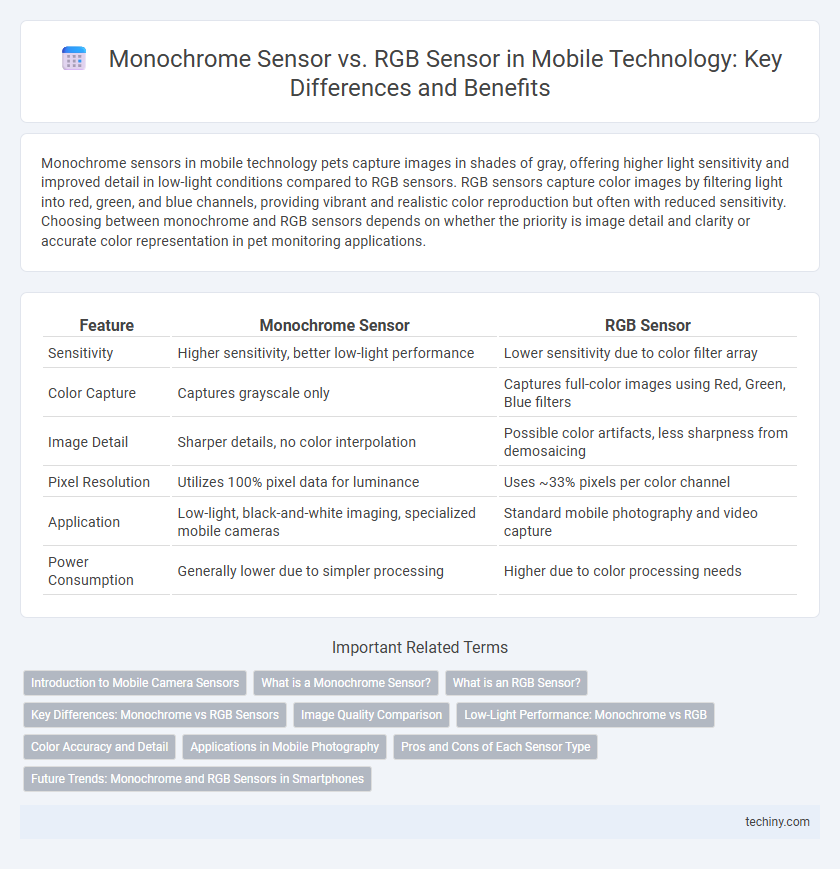Monochrome sensors in mobile technology pets capture images in shades of gray, offering higher light sensitivity and improved detail in low-light conditions compared to RGB sensors. RGB sensors capture color images by filtering light into red, green, and blue channels, providing vibrant and realistic color reproduction but often with reduced sensitivity. Choosing between monochrome and RGB sensors depends on whether the priority is image detail and clarity or accurate color representation in pet monitoring applications.
Table of Comparison
| Feature | Monochrome Sensor | RGB Sensor |
|---|---|---|
| Sensitivity | Higher sensitivity, better low-light performance | Lower sensitivity due to color filter array |
| Color Capture | Captures grayscale only | Captures full-color images using Red, Green, Blue filters |
| Image Detail | Sharper details, no color interpolation | Possible color artifacts, less sharpness from demosaicing |
| Pixel Resolution | Utilizes 100% pixel data for luminance | Uses ~33% pixels per color channel |
| Application | Low-light, black-and-white imaging, specialized mobile cameras | Standard mobile photography and video capture |
| Power Consumption | Generally lower due to simpler processing | Higher due to color processing needs |
Introduction to Mobile Camera Sensors
Monochrome sensors in mobile cameras capture light intensity without color filters, offering higher sensitivity, improved low-light performance, and sharper detail compared to RGB sensors. RGB sensors use red, green, and blue color filters to create full-color images but often sacrifice light sensitivity and resolution due to pixel color filtering. The choice between monochrome and RGB sensors significantly impacts image quality, dynamic range, and noise levels in mobile photography.
What is a Monochrome Sensor?
A monochrome sensor captures light intensity without color filters, resulting in higher sensitivity and sharper images compared to RGB sensors. It detects shades of gray by recording luminance, which enhances detail and reduces noise in low-light conditions. Monochrome sensors are commonly used in mobile technology for black-and-white photography, night vision, and scientific imaging applications.
What is an RGB Sensor?
An RGB sensor captures light through red, green, and blue filters to produce full-color images by combining these primary colors in varying intensities. This sensor type is essential in smartphones and tablets for accurately reproducing a wide color spectrum in photos and videos. RGB sensors offer enhanced color fidelity and detail compared to monochrome sensors, which only detect light intensity without color information.
Key Differences: Monochrome vs RGB Sensors
Monochrome sensors capture images using a single luminance channel, resulting in higher sensitivity and sharper detail due to the absence of color filter arrays, which reduces light loss. RGB sensors utilize separate red, green, and blue filters to produce full-color images but often suffer from lower light efficiency and reduced resolution per channel. The fundamental difference lies in monochrome sensors prioritizing brightness and clarity, while RGB sensors provide color information essential for accurate color reproduction.
Image Quality Comparison
Monochrome sensors capture images without color filters, allowing more light to reach the sensor and resulting in higher resolution and better low-light performance compared to RGB sensors. RGB sensors use color filters to capture red, green, and blue channels, which can reduce sharpness and introduce color noise, affecting overall image clarity. In mobile technology, monochrome sensors often produce superior detail and contrast, enhancing image quality especially in challenging lighting conditions.
Low-Light Performance: Monochrome vs RGB
Monochrome sensors outperform RGB sensors in low-light conditions by capturing more light due to the absence of color filters, resulting in higher sensitivity and better image clarity. RGB sensors, with their Bayer filter array, reduce light intake per pixel, leading to increased noise and lower detail in dim environments. Enhanced light absorption of monochrome sensors makes them ideal for applications requiring superior night-time or low-illumination mobile photography.
Color Accuracy and Detail
Monochrome sensors capture light without a Bayer filter, resulting in higher sensitivity and sharper detail compared to RGB sensors, which use color filters to separate red, green, and blue channels. RGB sensors provide accurate color reproduction essential for vivid, true-to-life images, while monochrome sensors sacrifice color accuracy for enhanced detail and low-light performance. Mobile devices often balance these sensor types to optimize image quality, leveraging monochrome sensors for fine details and RGB sensors for accurate color rendering.
Applications in Mobile Photography
Monochrome sensors in mobile photography excel in low-light conditions by capturing more light and detail since they do not use color filters, making them ideal for night shots and black-and-white images. RGB sensors provide full-color information by using red, green, and blue filters, enabling accurate color reproduction and versatility for everyday photography. Combining both sensors in mobile devices enhances image quality by leveraging the monochrome sensor's luminance data and the RGB sensor's color detail, improving dynamic range and sharpness.
Pros and Cons of Each Sensor Type
Monochrome sensors capture images using only luminance information, resulting in higher sensitivity, increased sharpness, and better low-light performance compared to RGB sensors due to the absence of a color filter array. RGB sensors provide full-color images by capturing red, green, and blue channels simultaneously, which is essential for realistic color reproduction but often sacrifices light sensitivity and resolution because of the interpolation process. Monochrome sensors excel in detail and contrast for black-and-white imaging applications, while RGB sensors remain the standard for vibrant, color-accurate mobile photography despite their slightly lower sensitivity and potential noise in dim environments.
Future Trends: Monochrome and RGB Sensors in Smartphones
Monochrome sensors in smartphones deliver higher light sensitivity and improved low-light performance by capturing more luminance data without color filters, enhancing image clarity. Emerging trends indicate integration of monochrome and RGB sensors to leverage the color accuracy of RGB with the sharpness and detail from monochrome sensors, pushing computational photography advancements. Future smartphone camera systems will increasingly adopt multi-sensor arrays combining monochrome and RGB technologies to achieve superior dynamic range, depth mapping, and AI-driven image enhancements.
Monochrome Sensor vs RGB Sensor Infographic

 techiny.com
techiny.com